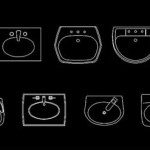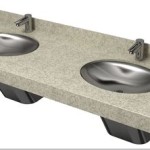Definition of Bathroom Sink
A bathroom sink is a vital fixture in any bathroom, serving as a primary location for handwashing, brushing teeth, and various other hygiene tasks. It is typically a bowl-shaped basin, often made of ceramic, porcelain, or stainless steel, with a faucet for dispensing water. Bathroom sinks come in a wide variety of styles, sizes, materials, and designs to complement any bathroom decor.
Key Features of a Bathroom Sink
While the basic functionality of a bathroom sink remains consistent, several essential features contribute to its overall usability and design:
1. Basin
The basin is the main component of a bathroom sink, serving as the receptacle for water. It is typically made of a durable material that is resistant to water damage and staining. Common basin materials include:
- Ceramic: Popular for its smooth, glossy surface, durability, and affordable price. It is also easy to clean and maintain.
- Porcelain: Similar to ceramic but often considered more luxurious due to its finer finish and high durability.
- Stainless steel: A highly durable and hygienic option that is often chosen for its modern look and resistance to rust and scratches.
- Acrylic: A lightweight and affordable alternative, but it may be less resistant to scratches and stains than other materials.
- Glass: A visually stunning option, often used for contemporary designs. However, it can be prone to scratches and may require more careful maintenance.
2. Faucet
The faucet is responsible for controlling the flow of water to the sink. It can be single-hole, double-hole, or widespread, depending on the design and the number of handles. Faucets come in a variety of styles and finishes, such as chrome, nickel, bronze, and gold. They may also offer features like:
- Temperature control: Allows the user to adjust the water temperature to their preference.
- Spray settings: Provides different spray patterns, such as a standard stream or a powerful spray for cleaning.
- Touchless activation: Offers a more hygienic experience by eliminating the need to touch the faucet handles.
3. Drain
The drain is located at the bottom of the basin and allows for the removal of water. It typically features a stopper that can be opened and closed to control the flow of water. Some drains also incorporate overflow features that prevent the basin from overflowing in case of accidental overfilling.
4. Countertop or Pedestal
Bathroom sinks are often integrated with a countertop or pedestal, which provides support and aesthetic appeal. Countertops can be made of various materials like granite, marble, laminate, or wood, offering a range of colors and textures. Pedestals are freestanding supports that create a more elegant and traditional look. These features contribute to the overall design and functionality of the bathroom sink.
Types of Bathroom Sinks
Bathroom sinks come in various types, each designed with specific features and purposes in mind. Some of the most common types include:
1. Vessel Sinks
Vessel sinks sit above the countertop, creating a unique and stylish design element. They typically feature a wide, bowl-shaped basin and offer a variety of materials and finishes. Vessel sinks are often chosen for their contemporary appeal and can add a touch of luxury to any bathroom.
2. Undermount Sinks
Undermount sinks are installed beneath the countertop, offering a seamless and streamlined look. They provide a clean and modern aesthetic and are often chosen for their ease of cleaning. Undermount sinks are typically made of stainless steel or ceramic.
3. Wall-Mounted Sinks
Wall-mounted sinks are attached directly to the wall, leaving the countertop clear for other fixtures or storage. They offer a minimalist and space-saving design, ideal for smaller bathrooms. Wall-mounted sinks often come with a vanity cabinet or shelf for storage.
4. Console Sinks
Console sinks feature a freestanding base with an open design that provides storage space beneath the sink. They offer a classic and elegant style and are often made of wood or metal.
5. Vanity Sinks
Vanity sinks are typically part of a larger vanity unit, which includes a countertop, cabinet, and sometimes a mirror. They are available in various sizes and styles to suit different bathroom layouts. Vanity sinks offer ample storage space and can be customized to match the desired aesthetic.
The selection of the appropriate type of bathroom sink depends on the specific requirements and design preferences of the user. Factors such as space availability, desired style, and budget are crucial in determining the best choice for a particular bathroom.

What Is The Difference Between Sink And Wash Basin

Sink Wikipedia

Sink 2 Noun Definition Pictures Pronunciation And Usage Notes Oxford Advanced American Dictionary At Oxfordlearnersdictionaries Com

What Is Vessel Sink Definition Of

What Is A Bathroom Vanity

The 15 Types Of Bathroom Sinks Family Handyman

Chapter 6 Lavatories And Sinks

Sink Wiktionary The Free Dictionary

What Is A Bathroom Vanity

Bathroom Vanity Counter Sink Ideas
Related Posts







